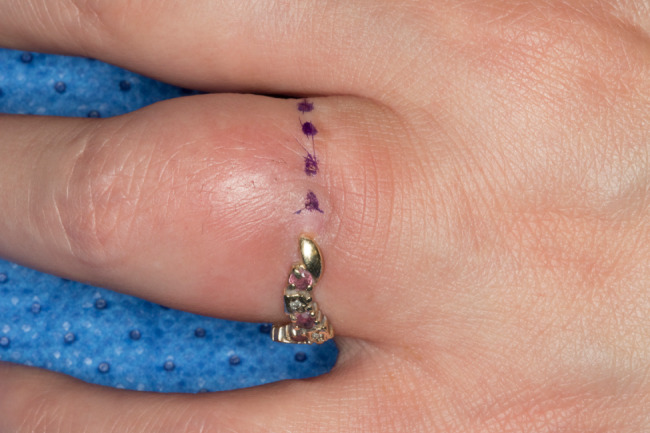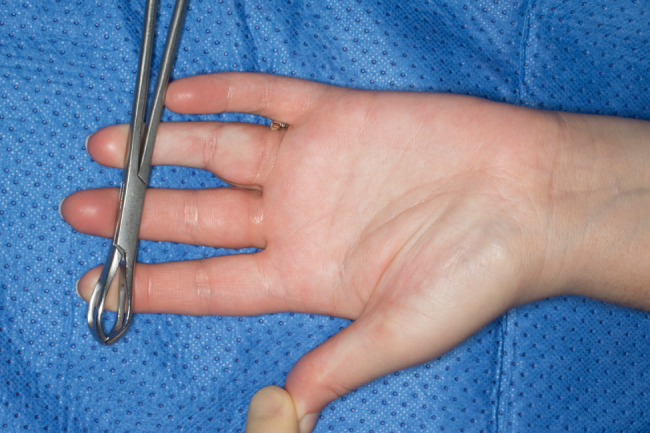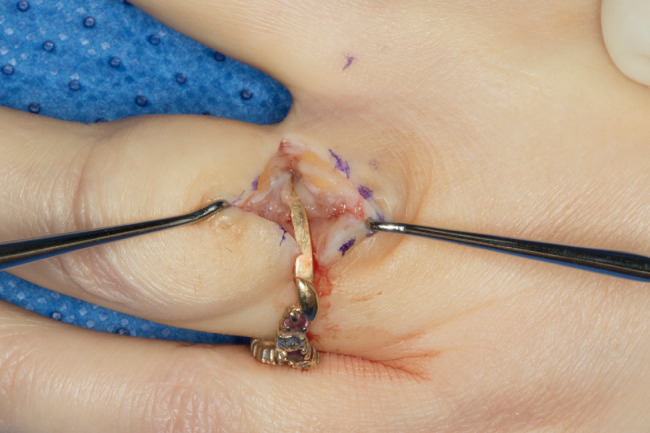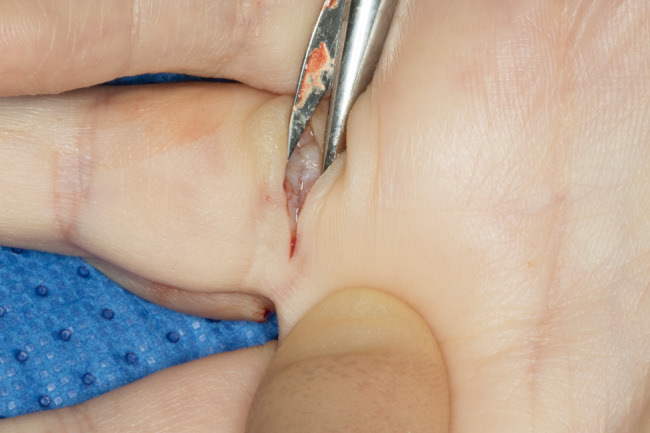Abstract
A 45‐year‐old female patient presented to clinic with an almost completely embedded ring in the volar aspect of her right ring finger, with complete reepithelialisation over the superficial aspect of the ring. We present this unusual case of an embedded ring after an insect bite on the patient's ring finger. The patient had worn the ring for the previous 5 years without removing it and did not report any discomfort or traumatic injury. We discuss this case in the context of previously reported cases of an embedded ring, a rare presentation in itself, highlighting the key differences in both this patient's aetiology and the risk factors associated with the presentation.
Keywords: Digit, Embedded, Erosion, Ring
Introduction
An embedded ring is a rare presentation usually associated with hand trauma or psychiatric comorbidity. We report the unusual case of a 45‐year‐old woman presenting with a near total embedded ring after an insect bite.
Case report
A 45‐year‐old female museum worker presented to the clinic with a near totally embedded ring, with only the head of the ring remaining visible over the dorsal aspect of her right ring finger. The patient had worn the ring without removing it for the past 5 years without discomfort or hand injury. Several months prior to presentation, the patient had noticed an insect bite on her ring finger, which had subsequently caused some mild oedema and chronic erosion underneath the ring. This prevented removal of the ring but did not concern the patient as she expected it to resolve. This oedema did subsequently resolve but with the volar aspect of the finger having reepithelialised over the surface of the ring, leaving it embedded within the patient's finger. The patient presented to the clinic following resolution of this oedema as a result of being unable to remove the ring. Other than the embedment of the ring, the patient was asymptomatic, with full range of movement, no neurovascular compromise and no pain on movement of the finger. Notably, the patient had no history of hand trauma, hand surgery or smoking, nor did she have a psychiatric comorbidity to explain the presentation.
Clinical examination of the right ring finger revealed a ring embedded within the soft tissue of the proximal phalanx with only the most dorsal aspect still visible (Figure 1). Reepithelialisation had occurred over the embedded ring, and some mild oedema was present in the distal digit (Figure 2). No neurovascular compromise was found, and there was no sign of infection.
Figure 1.

Visible aspect of the ring.
Figure 2.

Reepithelialisation over the embedded ring.
The ring was subsequently removed under general anaesthesia. An incision was made to expose the ring through the overlying soft tissue, and wire cutters were used to cut the ring before being bent and removed (Figure 3). The track formed by the ring was found to cover 80% of the circumference of the digit and was not lined by skin (Figure 4). Excess skin was trimmed from the wound margin before it was dressed and left to close through secondary intention.
Figure 3.

Exposing the embedded ring.
Figure 4.

Exploring the track formed by the ring.
Discussion
Embedded ring injuries are rare and usually associated with psychiatric or neurological comorbidity with associated cognitive dysfunction 1, 2; occasionally, however, cases have been reported secondary to traumatic injury 3, 4.
Patients are usually adults 5, 6 and female 7, and the common association with a psychiatric comorbidity has been recognised as embedded ring ‘syndrome’ 3.
Neurovascular damage to the digit is rare because of the underlying anatomy but has been reported 3, and one case of revascularisation over the outer surface of the embedded ring has been recorded 8. More common, however, is a restriction of movement because of the chronic inflammation causing tendon adhesion and rupture 7.
The mechanism of injury is likely often because of a ring being too tight around the finger, with a tourniquet like effect, leading to oedema of the soft tissues, erosion of the ring through the soft tissue and reepithelialisation over the outer aspect of the ring 7. Commonly, only mild discomfort is reported by these patients with late presentation resulting in progressive embedment of the ring 6, 9.
Treatment can be via a range of methods depending on clinical indication, from lubrication and axial traction to surgical exploration and cutting through the ring itself 2. Prognosis is usually excellent with removal of the ring and simple wound care 7 and commonly results in no long‐term loss of function, although hand therapy may be required 10.
Embedded ring injury is a rare presentation, but when it does occur, it is commonly either because of hand trauma or personal neglect on a background of psychiatric illness. Our case demonstrates a novel aetiology, with digital oedema secondary to an insect bite causing a ring to become embedded within the soft tissue of the patient's finger.
Acknowledgement
This work has not previously been presented in any format. No funding was received for any part of this work. There are no conflicts of interest to disclose. Informed consent was obtained from the patient.
References
- 1. Deshmukh N, Stothard J. The embedded ring injury — case report and review of literature. Hand Surg 2003;08:103–5. [DOI] [PubMed] [Google Scholar]
- 2. Kumar A, Edwards H, Lidder S, Mestha P. Dangers of neglect: partially embedded ring upon a finger. BMJ Case Rep 2013: 10.1136/bcr-2013-009501 [DOI] [PMC free article] [PubMed] [Google Scholar]
- 3. Takamatsu K, Okada M, Ikeda M, Nakamura H, Uemura T. Entrapment of digital nerves due to an embedded ring: a case report. J Reconstr Microsurg 2014;30:659–62. [DOI] [PubMed] [Google Scholar]
- 4. Magos T, Sheikh Z. An embedded finger ring. J Emerg Med 2015;48:470–1. [DOI] [PubMed] [Google Scholar]
- 5. Bennett K, Brou J, Levine N. Completely embedded ring in the finger of a growing child. Ann Plast Surg 1995;34:76–7. [DOI] [PubMed] [Google Scholar]
- 6. Witt P. Uncommon features of an uncommon problem: embedded ring syndrome in a child. Plast Reconstr Surg 2007;119:1631–2. [DOI] [PubMed] [Google Scholar]
- 7. Leung Y, Ip S. Chronic erosion injury of a digit by a ring: epidemiology, staging, treatment and prognosis. Br J Plast Surg 2002;55:353–5. [DOI] [PubMed] [Google Scholar]
- 8. Awan B, Samargandi O, Aljaaly H, Makhdom A. Single patent vessel over an embedded ring: a case report. Hand Surg 2013;18:125–8. [DOI] [PubMed] [Google Scholar]
- 9. Drewniany J, Palmer A, Levinsohn E. An unusual presentation of a ring injury. J Hand Surg 1982;7:194–5. [DOI] [PubMed] [Google Scholar]
- 10. Fraser K, Jamison D. Embedded‐Ring Syndrome. Ann Emerg Med 1995;25:856–7. [DOI] [PubMed] [Google Scholar]


